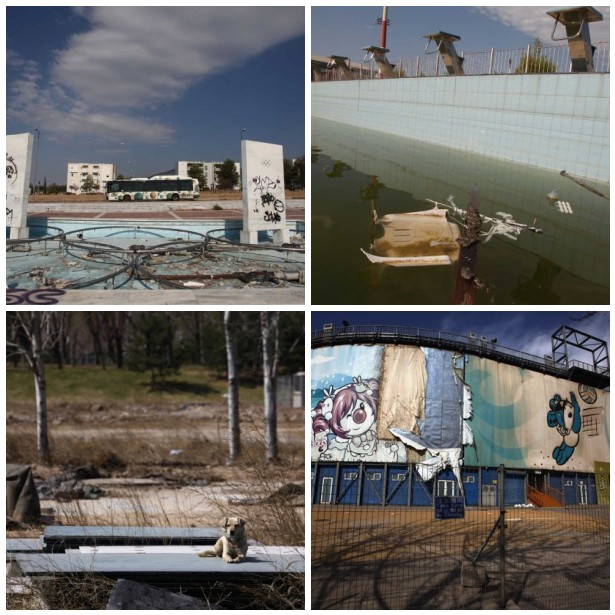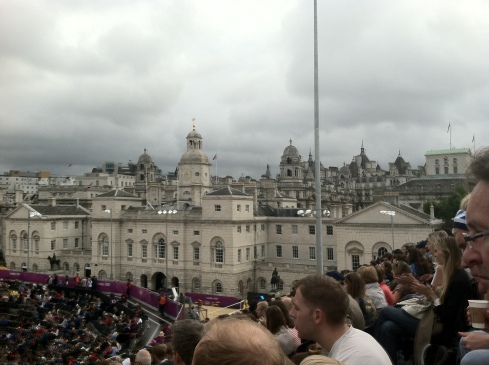
The Olympic Legacy...First Hand
With all the talk and excitement flying around about the London 2012 Olympics, I couldn’t help but weigh in with my experience at the games last week. My husband and I were fortuitous enough to attend the games in person this summer, and experience all that came along with it, including transportation, access, etc. I tried to soak in as much of the probably once-in-a-lifetime event as I could, shuffling myself between venues.
I love the culture and excitement of these 2 weeks as much as the next spectator, but of course, as an urban designer and planner, the question most on my mind is what will the legacy be for the Olympic Park? Its design was promised to transform the east side of London, desperately in need of redevelopment. It was entirely on this argument that London won the bid, showing the derelict and blighted conditions of East London, while Paris focused on what made it glorious, the Arc de Triomphe and the Louvre.
So with a big promise, London 2012, now has a big job ahead of them. As the Games came to a close this past weekend we need to ask, how does London ensure that its Olympic site will be a catalyst for regeneration and sustainably revive an entire part of the city?
I should say my Olympic experience is limited. London was my first visit to the Olympics, however, I did visit the Estadi Olímpic Lluís Companys in Barcelona in 2005, 13 years after it hosted in 1992. My trip to Barcelona set the status quo for the challenge that cities have in sustaining the life in their Olympic sites. We arrived to an abandoned site, locked from any passing visitors. Perched on a hilltop separated from the city, the tram that we took to the top ran infrequently and was empty. We took some pictures next to Calatrava’s Communication Tower (the most eloquent structure by far), and left disappointed by the experience. In truth, after the whole world attached a physical place with so much glory, how is it ever to live up to the same excitement again? … it can’t.
Other cities have programmed the life out of their Olympic sites to try to keep them alive. Atlanta transformed its venues for every day use well, and Sydney has added accommodation and entertainment venues to make it more of an attraction. It’s website portrays a healthy and active place. Perhaps these two cities have had more time to transform their parks, because the documented current conditions of Athens and Beijing have been not so successful.
Both Athens and Beijing Olympic Parks currently suffer from lack of investment and maintenance. Venues have fallen into disrepair and calls for development have been made. It appears that there was little consideration for a legacy.

The top pictures show the dilapidated conditions of the Athens Olympic Park, the bottom showing the poorly maintained conditions of Beijing’s venues. (Images: SF Gate and Yahoo Sports)
From all appearances, London has made the wise choice to not preserve the Olympic site as it is, but instead transform it to what it needs to be. The venues that did not serve a purpose for the community were built to be temporary; the ones that were needed received the highest quality of design and construction. This strategic urban and site planning, allowed them to concentrate funding where it would matter the most, and plan the temporary venues in locations that could be transformed with the most ease.
That was very apparent when I visited the Olympic site. A large park lining a canal served as the spine that gave structure to the rest of the site. It clearly was very well-funded, and intelligently planted with indigenous plant and wild flowers, which require little maintenance. The venues that would serve the community after the Games, were beautifully designed. The Velodrome that I affectionately call the “Pringle,” is one of the most beautiful buildings I have ever seen.
Also, beautifully designed was the Aquatic Center. While the community needed a swimming facility, they did not need one that was large enough to accommodate an Olympic audience. Therefore, the center was designed to be transformed and reduced in size after the Games. Attached to each end, were large temporary stands. The distinction between the two structures was apparent.
The same is true of the fate of the Olympic Stadium. Commonly preserved in its Olympic state, stadiums can often suffer from not having a common use after the Games. Like the stadium in Atlanta, which was turned over to the Atlanta Braves, the stadium in London will be turned over to a professional soccer team, most likely Westham United. It will be restructured, reduced in size, to accommodate the appropriate sized audience.
Other venues were apparently very temporary. The Riverbank Hockey Centre and the BMX track were nothing but glorified scaffolding. Some studios and support buildings were made out of stacked shipping containers. When I turned to corner, or looked a little too closely, I could see the inter-workings of the games barely hidden behind some slipped canvas on a fence. The basketball arena, even though beautifully designed, will be taken down and rebuilt in Rio for the 2016 Olympics.
The result, at least for me, was that it did not feel magical. It did not feel like the Olympic site was designed to create a perfect experience for the Olympic visitor. There were holes and gaps in the perfection.
That was refreshing.
Below are two site plans, the right as it is now, and the left, how it will transformed. The heart of the Olympic village that surrounds the park will be preserved, and the parts of the site that border existing neighborhoods will be redeveloped as mixed-use developments. This will serve as a buffer between parts of the city that are in the most desperate need of redevelopment and the uniqueness of the remaining Olympic venues. While it is still to be determined how sustainably designed these neighborhoods will be, the site plan is promising.
At the very least, the largest mall in Europe and a world-class international high-speed train station that will soon overtake the famous Victoria station in trips, ensure the Park will be well-visited and benefit from good access. The site planning strategy and greater regional planning by London will ensure the Park’s legacy and future success.

Left: London 2012 Olympic Park designed for the Olympic Games; Right: the Park transformed after the Games (Image: London Legacy Development Corporation)
In addition to the physical design of the site, it is also programmed for the following uses:
- Part of the East London Tech City Technology hub.
- The largest urban park in Europe, designed specifically to enrich local ecology through wetlands and native species.
- A new university will be founded that will specialize in sport science, digital media, and green technology.
- The facilities will be open to the public.
- The Olympic Village will be converted to apartments.
- Allotments will be reinstated and created.
London creatively used other existing venues throughout the city, and south of the country, to minimize the size and impact of the Olympic park. The most exciting Olympic experience might have been watching beach volleyball in temporary stands in the heart of Horse Guards Parade. London had enough foresight to take advantage of the beautiful architecture filled in the city…why build a stadium, when a historic building would be more beautiful.
Not only did this allow funds to be used appropriately to ensure the Olympic site’s legacy, it also made the games run more sustainably and efficiently. With events spread out throughout the city, public transportation never became to crowded or bogged down. We could walk, train, and drive everywhere we needed to go with ease.
Only time will tell if London’s Olympic Park will suffer the same fate as Beijing and Athens, or the redevelopment success of Atlanta and Sydney. However, from a first hand experience of the Games, it is clear that the foundation for greatness has been set. Investment, maintenance, and a commitment to the legacy the city has promised will determine the future of East London.
Erin Chantry is the author of At the Helm of the Public Realm. She is an Urban Designer in the Urban Design and Community Planning Service Team with Tindale-Oliver & Associates. Here is the original content.






Comments
Write your comments in the box below and share on your Facebook!